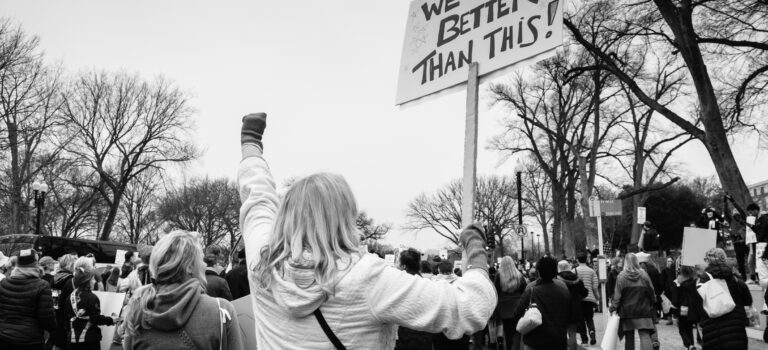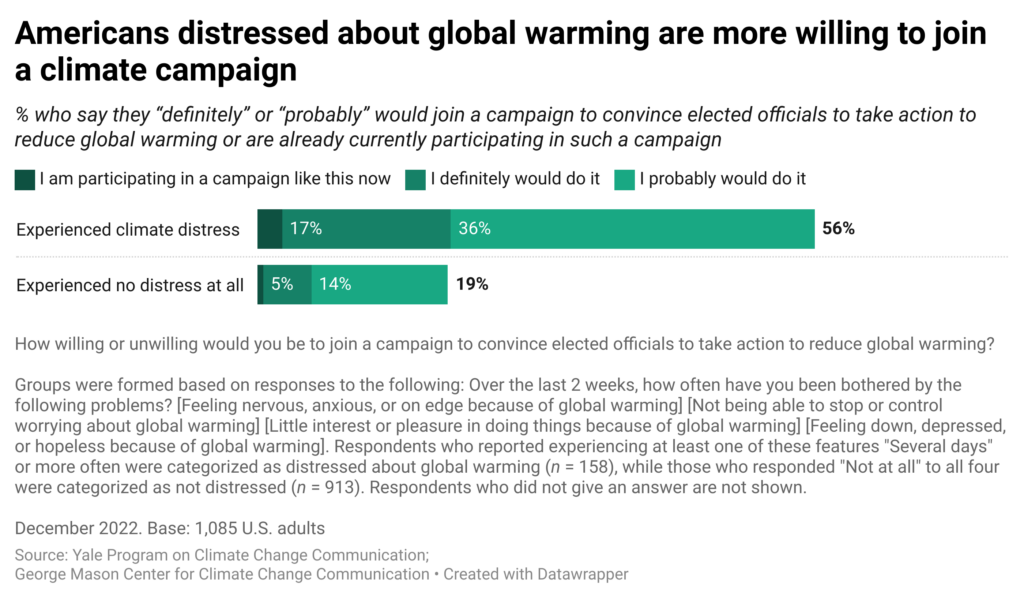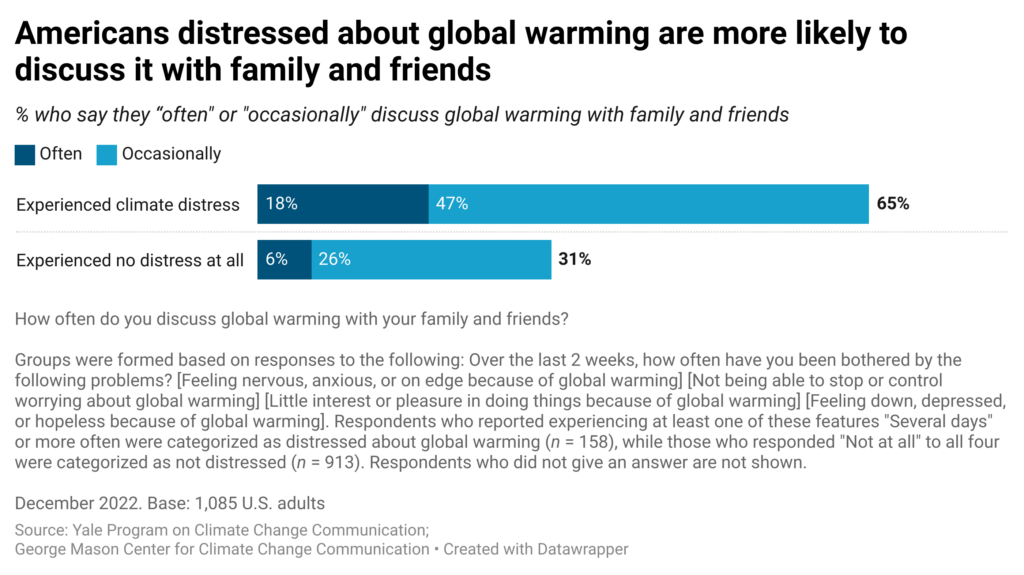Climate Note · Aug 3, 2023
Is distress about climate change associated with climate action?
By Matthew Ballew, Teresa Myers, Sri Saahitya Uppalapati, Seth Rosenthal, John Kotcher, Eryn Campbell, Emily Goddard, Edward Maibach and Anthony Leiserowitz
Filed under: Audiences and Beliefs & Attitudes

The effects of climate change on mental health are growing. Many studies show that rising temperatures and climate impacts, such as wildfires and floods, can directly and indirectly contribute to psychological distress about climate change, including feelings of helplessness, depression, grief, or anxiety (often referred to as “eco-anxiety”).
Psychological Distress from Climate Change
People who directly experience climate- or weather-related disasters often suffer from serious mental health consequences – including post-traumatic stress disorder, anxiety, and depression – which often occur simultaneously and can have long-lasting effects. Some groups are especially at risk, including youth, older adults, people of color, Indigenous populations, lower-income individuals, women, people with disabilities, and people with pre-existing medical conditions.
The negative effects of climate change can also be experienced indirectly (e.g., learning about its severity and hearing about others’ experiences from friends or family members, or through the media), which can lead to psychological distress about climate change. Experiencing distress can impact behavior and potentially lead to maladaptive behaviors, including avoidance and decreased engagement with climate issues, as ways to cope with the distress. However, some research shows the opposite – that experiencing distress about climate change can prompt an adaptive behavioral response and motivate people to take climate action. In turn, taking action, especially joining a group or social movement working on climate change, can help people overcome their negative emotions.
Here, we investigate whether distress about climate change is associated with climate action (e.g., political actions, discussion of climate change with family and friends, etc.) using data from our December 2022 Climate Change in the American Mind survey. The findings highlight the importance of providing people distressed about climate change with ways to act on their concerns.
Climate Distress and Climate Action
In December 2022, we found that about one in ten Americans reported experiencing at least one feature of climate distress (anxiety or depression because of global warming). In this analysis, we compare Americans who reported at least one feature of climate distress to those who reported no distress at all.
The Climate Distressed Are More Likely to Act
Americans who had experienced at least one feature of climate distress were much more likely than those who had not to say they had taken different forms of climate action. This includes having signed a petition about global warming (46% vs. 10%, respectively), or having volunteered at an organization working on global warming (19% vs. 2%).
The Climate Distressed Are Willing to Take More Action
Americans who reported climate distress were also much more willing to take climate action compared to those who did not report any distress. For instance, Americans who experienced at least one feature of climate distress were more likely than those who had not to say they would meet with an elected official or their staff about global warming (41% vs. 20%, respectively), write letters, email, or phone government officials about global warming (40% vs. 21%), or personally engage in non-violent civil disobedience (e.g., sit-ins, blockades, or trespassing) against corporate or government activities that make global warming worse (35% vs. 9%).
The Climate Distressed Are More Likely to Join a Climate Campaign
Additionally, Americans who reported experiencing at least one feature of climate distress were more likely to say they would join a campaign to convince elected officials to take action to reduce global warming or are already participating in such a campaign, compared to those who reported no distress (56% vs. 19% respectively).
The Climate Distressed Are More Likely to Discuss Global Warming
Americans who had experienced at least one feature of climate distress were also much more likely to say they discuss global warming with family and friends (65%) than those who reported no distress (31%)For tabulation purposes, percentage points are rounded to the nearest whole number and summed categories (e.g., Often + Occasionally) are rounded after sums are calculated (e.g., 5.67% + 25.60% = 31.27%, which after rounding would appear in this report as 6% + 26% = 31%)..
These findings align with other research indicating that climate distress is associated with increased pro-climate action. Importantly, while distress like eco-anxiety can be maladaptive and potentially lead to serious mental health consequences (e.g., interfering with behavior and daily functioning including sleep, socializing, and work performance), it can also serve an adaptive function and motivate proactive behavior to cope with the problem. Experiencing a certain level of distress in response to the realities of climate change is natural and understandable. Channeling that distress into climate action can both help these individuals cope constructively and address climate change at the same time. According to Dr. Susan Clayton, professor of psychology at the College of Wooster, “involvement in climate change activism could be described as a form not just of coping but of adaptation – adjusting to a new way of life.”
Resources for Coping with Climate Distress
Providing people with opportunities to take climate action, especially as part of climate-related communities and social groups, can help them manage their feelings of distress, while also empowering them to generate social change. For example, research has found that engaging in climate action can help young people cope with their negative feelings about climate change and experience positive feelings such as hopefulness, determination, and a sense of agency. Engagement can also help build social connections, which can promote positive emotions and resilience. The psychological effects of climate change are multifaceted, however, and it is important to carefully consider individual differences, experiences, and needs.
As the frequency and severity of climate impacts increase, it is important to provide people with resources and interventions to support mental health. To learn more about climate-related mental health resources, please visit the Climate Mental Health Network.
Methods
The results of this report are based on data from the December 2022 Climate Change in the American Mind survey (n = 1,085) – a biannual nationally representative survey of U.S. public opinion on climate change conducted by the Yale Program on Climate Change Communication and the George Mason University Center for Climate Change Communication. Data were collected from December 2 – 12, 2022 using the Ipsos KnowledgePanel®, a representative online panel of U.S. adults ages 18 and older. Respondents self-administered the questionnaires online in a web-based environment.
In Figure 1, for the question “Over the past 12 months, how many times have you done the following? Written letters, emailed, or phoned government officials about global warming,” respondents were provided a follow-up question if they said they had performed this behavior at least “once.” Respondents who selected “When you contacted a government official did you… Urge them to take action to reduce global warming?” to this follow-up question were categorized as having written letters, emailed, or phoned government officials about global warming at least “once” over the past 12 months.
Groups were formed based on responses to the following: Over the last 2 weeks, how often have you been bothered by the following problems? [Feeling nervous, anxious, or on edge because of global warming] [Not being able to stop or control worrying about global warming] [Little interest or pleasure in doing things because of global warming] [Feeling down, depressed, or hopeless because of global warming]. Respondents who reported experiencing at least one of these features “Several days” or more often were categorized as distressed about global warming (n = 158), while those who responded “Not at all” to all four were categorized as not distressed (n = 913). Respondents who did not give an answer are not shown.
Data for each survey wave were weighted to align with demographic parameters in the United States. Group differences were tested for statistical significance using the weighted proportions and unweighted sample sizes of each group. In figures/data tables, bases specified are unweighted, while percentages are weighted to match national population parameters. For tabulation purposes, percentage points are rounded to the nearest whole number. As a result, summed categories (e.g., Often + Occasionally) are rounded after sums are calculated (e.g., 5.67% + 25.60% = 31.27%, which after rounding would appear in this report as 6% + 26% = 31%). The average margin of error is +/- 3 percentage points at the 95% confidence interval for the full sample of U.S. adults (n = 1,085), +/- 7.8 for the subgroup of people who reported at least one feature of distress at least “several days” or more often over the last two weeks (n = 158), and +/- 3.2 for the subgroup of people who reported no distress at all over this time span (n = 913). The data tables used to develop the charts/figures can be found here.



